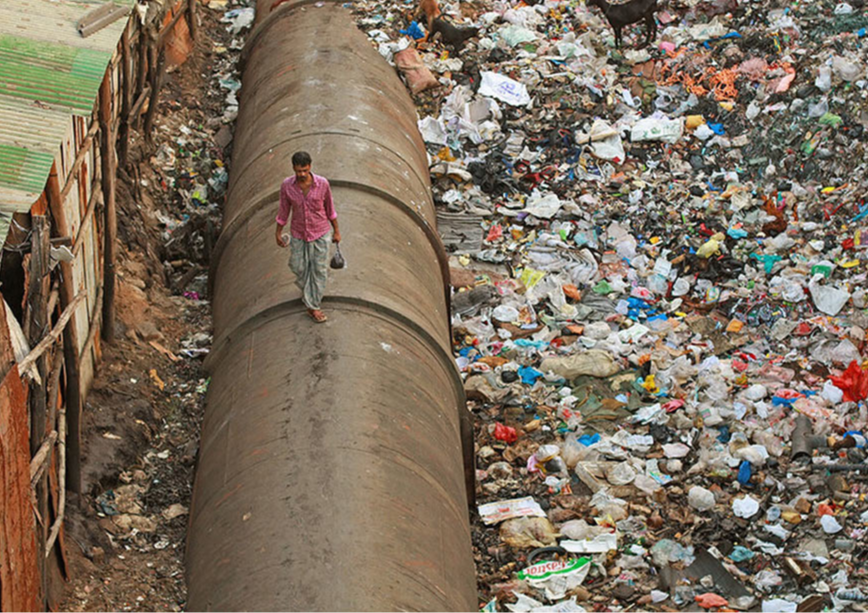
Source Image: © Meena Kadri
Maintaining sanitation in populous urban centres is a major urbanisation challenge in India. The large number of urban dwellers leads to high quantities of solid waste. However, it needs to be noted that administrative efficiencies in the proper handling of waste are also low. The irregularity results in waste dumping on vacant lands, in surface water bodies, and along roadsides. This is a common sight across urban India, and the prevailing unhygienic conditions have numerous harmful impacts.
The existing problems in India’s urban waste management sector are being addressed in various ways. Although the law empowers state and local governments to perform the duty of sanitation, the national government also offers the required support. The Swachh Bharat Mission (Urban), or SBM (U), for example, is a centrally sponsored scheme that is operational for making urban centres free from open defecation and achieving 100 percent scientific management of solid waste in all statutory towns of the country. In the interim union budget for 2024-25, an amount of INR 50 billion is allocated for this purpose. Similarly, under the Smart Cities Mission, numerous waste management projects (such as bio-CNG plants to produce biogas, remote monitoring of waste collection and transportation processes, and decentralised micro compost centres) have been implemented in 100 urban centres in India. Furthermore, Solid Waste Management Rules, 2016 are formulated to guide the administration and waste generators in proper handling of solid waste.
The Swachh Bharat Mission (Urban), or SBM (U), for example, is a centrally sponsored scheme that is operational for making urban centres free from open defecation and achieving 100 percent scientific management of solid waste in all statutory towns of the country.
Since 2016, the Indian government has also started the annual practice of ranking municipalities based on their performance in waste management. The practice helps in understanding the sanitary conditions in urban centres and in identifying areas of concern. This article reviews the most recent (2023) awards given to municipalities and the methods adopted by these to improve sanitary conditions. The assessment also reveals names of municipalities that are lagging.
For awards, annual urban sanitation surveys (or Swachh Survekshan) are conducted by the Ministry of Housing and Urban Affairs (MoHUA) through a third-party assessment agency. Municipal performance is judged based on a wide range of indicators pertaining to waste collection, transportation, processing and disposal, as well as the empowerment of sanitary workers. The collection of feedback from citizens is an important survey component. Further, verification of conditions prevailing in urban centres is done through direct observation by assessors and citizen validation. Finally, cities are ranked based on marks obtained.
Some of the indicators include door-to-door waste collection, source segregation of waste, cleanliness of public areas, storm water drains, water bodies and public toilets, toilet facilities for differently-able persons, plastic waste management, promotion of reduce, reuse and recycle centres, development of waste to wonder parks and/or installation of waste to art sculptures, ensuring zero waste events (i.e. weddings, social or religious functions), promoting youth participation in campaigns and activities, municipal waste processing capacity, and presence of sanitary landfill.
Municipal performance is judged based on a wide range of indicators pertaining to waste collection, transportation, processing and disposal, as well as the empowerment of sanitary workers.
The 2023 survey results of 4,416 municipalities and 61 cantonment boards were declared in January 2024. Among the municipalities, Indore and Surat are ranked as the cleanest cities (or the number one best-performing cities), followed by Navi Mumbai, Visakhapatnam, Bhopal, Vijayawada, New Delhi, Tirupati, Greater Hyderabad, and Pune. The 10 cities received the highest scores on the above-mentioned indicators. It is noted that the cities generally lie in different states, and therefore a distinct state-level pattern is not visible. On the other extreme are 10 urban centres situated in the Northeastern state of Nagaland that have received the lowest scores on waste management indicators. Northeast media also reports that the region is generally lagging in maintaining sanitation.
According to the city report cards, Indore and Surat excelled due to their performance in door-to-door collection, source segregation, waste generation versus processing, remediation of dumpsites, and cleanliness of residential areas, markets, water bodies and public toilets. The other eight cities (among the top ten) fared slightly low in one or more parameters. In this regard, deficiencies are noted in source segregation, remediation of dumpsites, and cleanliness of public areas and water bodies.
Foremost among these are municipal managerial, financial, and technological capabilities in responding to the situation, as well as awareness of citizens.
Indore’s position has improved over the years because of several reasons. Instead of involving private operators, the municipality itself took responsibility for waste collection and disposal. It ensures that garbage workers, including informal rag pickers, collect segregated waste (wet, dry, plastic) from all households. All wet waste is converted into compost, and a treatment plant is established for dry waste. The issue of legacy waste (i.e. untreated/unsegregated waste dumped on waste disposal sites) is addressed through clearing and treatment. Regarding toilets, the requirements of people living in slums and along railway lines have been met. Simultaneously, people are informed about waste-handling methods. Thus, the efforts of the municipality along with changes in people’s habits helped Indore become the cleanest city.
In Surat, the municipality uses technology to maintain cleanliness. According to available information, any person throwing garbage in public places is noticed on CCTV cameras and quick remedial action is taken by municipal staff. Further, trash vehicles are equipped with global positioning systems (GPS) to ensure efficiency in collection and transportation.
The above review helps in understanding the basic requirements for maintaining sanitation in urban centres of India. Foremost among these are municipal managerial, financial, and technological capabilities in responding to the situation, as well as awareness of citizens. Urban centres lacking these requirements are at a loss.
Rumi Aijaz is a Senior Fellow at the Observer Research Foundation
The views expressed above belong to the author(s). ORF research and analyses now available on Telegram! Click here to access our curated content — blogs, longforms and interviews.




 PREV
PREV


